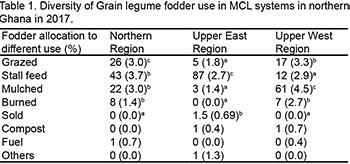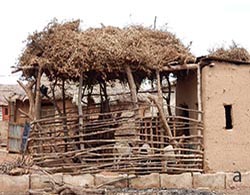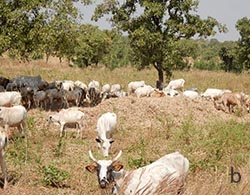Crop residues are a major feed resource in smallholder mixed crop-livestock (MCL) systems in West Africa. The current decline in grazing land as a result of the ever-increasing population and associated increased demand for land for housing and crop production has further heightened the importance of crop residues as livestock feed. Grain legume residues, also known as grain legume fodders (GLFs) are considered more valuable livestock feed than cereal residues since they have higher digestibility and protein content. Additionally, GLFs is used as fuel, construction material and mulch for soil improvement. The increasing demand for GLFs as livestock feed has implication for the long-term sustainability of MCL systems since failure to return the manure from livestock fed with the GLF to the fields could have a negative impact on soil quality to enhance crop productivity. One of the chapters in my PhD thesis focused on assessing the variation in the allocation of GLF in MCL systems in three regions with different population pressure and agro-ecological conditions in northern Ghana and how these variations impact on the role of GLFs in smallholder mixed crop-livestock systems.
We conducted household surveys in Northern (NR), Upper East (UER) and Upper West (UWR) regions in northern Ghana during the 2016 off-season, from November 2016 to January 2017. A total of 150 households were surveyed from 15 villages, five from one district each in each region (NR – Savelugu district; UER – Binduri; UWR – Nadowli) where the N2Africa Project (www.n2africa.org) was being implemented.
| The results show that farmers in the NR and UER use the majority of GLFs as livestock feed, which is stored for stall feeding or through free grazing (Table 1) in the dry season (Plate 1). In UWR, (61%) GLFs is left in the fields as mulch whereas about 30% ever-increasing as livestock feed (17% through open grazing and 12% through stall feeding) (Table 1). |  |
Less than 10 % of GLFs is burned to ease land preparation in NR and UWR while none of the GLFs is burnt in the UER. The intensified system in UER showed considerable pressure on GLFs as feed with limited surplus for other uses. In the more extensive system observed in UWR showed that the greater proportion of the GLFs were left on the field as mulch for soil amendment. The variation in the use GLFs as feed in northern Ghana had created an intensification gradient in the regions which made UWR less intense followed by NR and UER is the most intensive system.
| Plate 1: Grain legume fodders stored for stall feeding (a) and open grazing (b) in northern Ghana |  |
 |
Some driving factors such as the scarcity of feed from grazing land, number of livestock owned per household, the reason for keeping livestock and distance of crop fields from the homestead could explain these variations in the allocation of GLFs in MCL systems in northern Ghana. The higher usage of GLFs as feed in UER is due to scarcity feed from grazing land and differences in the agro-ecological conditions. Another reason for the higher use of GLFs as feed in UER is that about 80% of the households had cattle which are oxen or bullocks. These animals are major source of draught power for land preparation and carting of food, feed and manure. These animals, therefore, need maintenance feed to survive during the dry season. We also found that in both NR and UWR, crop production is the main source of income, followed by livestock production. In UER, however, income from both crop and livestock production are equally important (data not shown) for the households which made GLFs more valuable.
Based on the above findings we can conclude that there is variation in the allocation of GLFs in MCL system in northern Ghana. This variation in GLFs allocation was caused by the number and type of livestock kept in the household, distant of crop fields to the homestead, land scarcity and population density coupled with high demand for food. This show that livestock production in the smallholder MCL system is likely to continue to depend on GLFs as feed. Therefore there is the need to cultivate dual-purpose varieties of grain legume in tandem with innovations such as rhizobia inoculation and P fertilization to enhance the whole plant value of grain legumes without compromising quantity and quality of GLFs.
Daniel Brain Akakpo, Wageningen University & Research, The Netherlands (Click here for his 2018 update)
